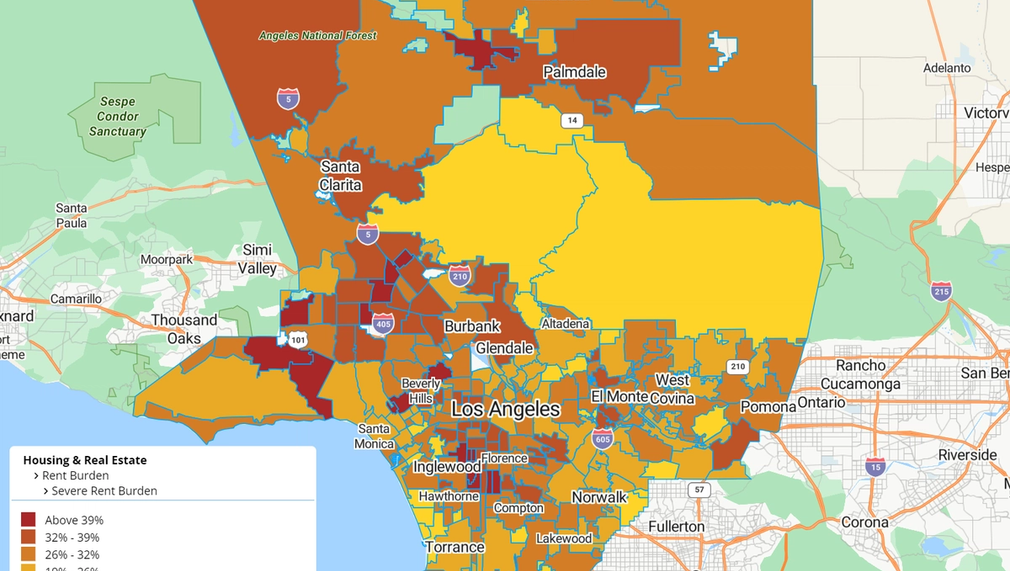Data-Driven Solutions to Los Angeles County's Housing Crisis
State of Los Angeles County Housing and Neighborhoods (SOLACHAN) is a new annual resource from Neighborhood Data for Social Change (NDSC). SOLACHAN will foster collective action around housing inequality and homelessness by linking high-quality spatial data and academic analysis with insights from developers and community representatives. It aims to create richer, evidence-based policy conversations and stronger cross-sectoral collaborations at a time when the housing crisis can seem intractable.

What is the primary issue area that your application will impact?
Affordable housing and homelessness
In what stage of innovation is this project, program, or initiative?
Pilot or new project, program, or initiative (testing or implementing a new idea)
What is your understanding of the issue that you are seeking to address?
The Los Angeles housing market is among the most expensive relative to income in the nation. Housing production is not keeping up with job growth across the metro area, building 44% slower than the national average. Despite a wealth of resources, the region has struggled to marshal an effective response to its housing crisis that reflects a shared vision, incorporates the best evidence, and coordinates efforts across sectors. LA County needs a forum for developing a collaborative agenda aimed at achieving healthy housing supply growth and preventing housing insecurity. This agenda must reflect the most rigorous available evidence and evolve with shifting contextual conditions and new information. It must also incorporate input from a myriad of stakeholders within the county. Given the history of fragmentation and distrust between many of these groups in Los Angeles, a reliable entity perceived as neutral and committed to data-informed discourse must lead this effort.
Describe the project, program, or initiative this grant will support to address the issue.
SOLACHAN is an annual resource that will offer detailed analysis and accessible, high-quality data about Los Angeles County’s housing, land use, and neighborhoods to address the multi-faceted nature of Los Angeles’ housing crisis. It has several components including an annual report, an annual symposium, and publicly available community data. The annual report will feature commentaries on pressing and policy-relevant issues such as housing production and homelessness. This report will also incorporate a recurring neighborhood data analysis on a core set of issues including homelessness, housing development, renting, homeownership, and affordability. To support the report’s annual release, NDSC will host a symposium to catalyze informed conversations about the current state of housing and neighborhoods, how best to plan investments, deliver resources, and influence local policymaking. Each year’s event and invited research commentaries will be organized around a specific theme that reflects the rapidly evolving body of research on housing and the broader landscape of housing inequality in Los Angeles. Beyond the annual symposium, NDSC will disseminate and build upon SOLACHAN’s findings through its traditional community-engagement tools including community trainings, social media videos, listening sessions, data stories, and custom data projects with community-based partners.
Describe how Los Angeles County will be different if your work is successful.
SOLACHAN aims to create a vibrant, data-driven, and widely-accessible forum for ongoing discussions and debates between academics, local officials, developers, community-based organizations and other members of the public. The process will also connect constituencies that might not otherwise interact, laying the groundwork for future regional partnerships. NDSC is well-positioned to lead this ambitious, cross-sectoral program due to its longstanding relationships with a diverse set of community partners, research centers and faculty members from academic institutions across Los Angeles County.
What evidence do you have that this project, program, or initiative is or will be successful, and how will you define and measure success?
Our team will measure success through a number of qualitative means. By closely monitoring both state and local housing policies we will identify where SOLACHAN has been effective in influencing policy decisions. Moreover, the success of our cross-sector approach will become apparent through mutual engagement across local & state government, housing advocacy non-profits, philanthropic organizations, and community members. This may also take the form of a unified housing agenda across municipalities and levels of government. In addition, NDSC will work to provide evidence and data around policy conversations that are often driven by fear and hyperbole. A better general understanding of the housing crisis amongst the public will make evident the success of a data-driven approach. To complement qualitative means, the team will track the number of website views to the NDSC platform. Analyzing these metrics over time will help us evaluate the impact that the platform has on our communities.
Approximately how many people will be impacted by this project, program, or initiative?
Direct Impact: 200.0
Indirect Impact: 10,000,000.0